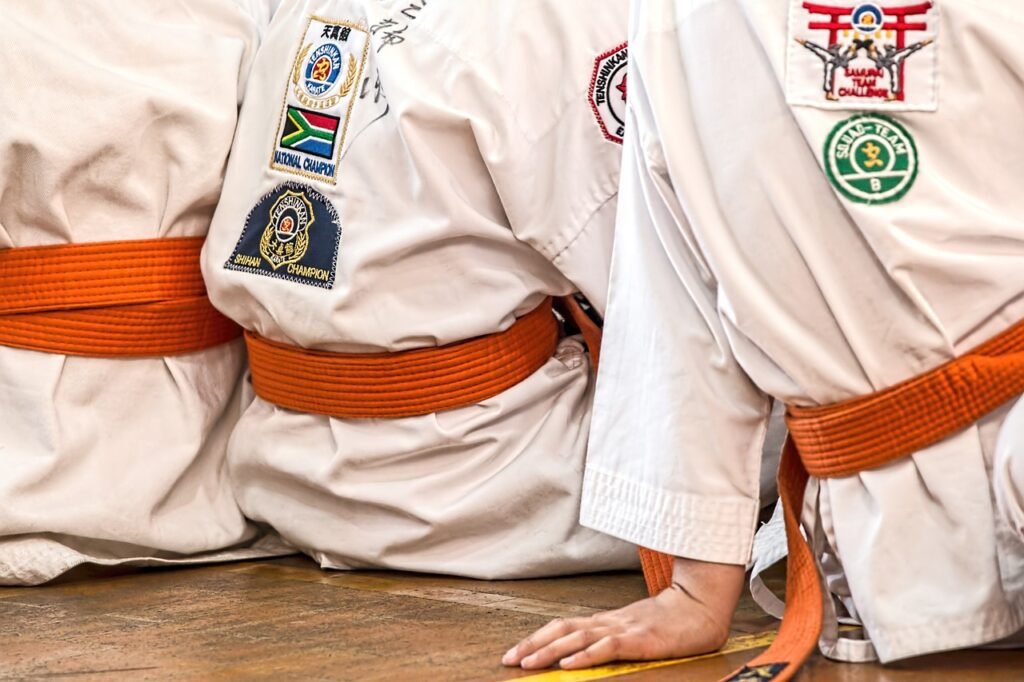In this article, you will discover the key to taking your skills in martial arts to the next level – mastering advanced techniques for breaking your opponent’s balance. Whether you’re a seasoned practitioner or just starting out, understanding how to disrupt your opponent’s stability can give you a significant advantage in any match. By focusing on these advanced techniques, you’ll gain the ability to control the rhythm of the fight, leaving your opponent off-balance and open for powerful strikes. So, get ready to enhance your martial arts repertoire and become a formidable force in the arena.
Understanding the Importance of Balancing in Combat
How balance affects a fighter’s performance
In combat, balance plays a crucial role in a fighter’s performance. Maintaining proper balance not only allows fighters to execute their techniques effectively, but it also increases their overall stability, speed, and power. Without good balance, fighters are more prone to being knocked off balance or losing control of their movements, making them vulnerable to attacks from their opponents. Additionally, balance is essential for maintaining a strong defensive posture, enabling fighters to deflect or absorb incoming strikes with greater efficiency.
The advantages of disrupting an opponent’s balance
Understanding how to disrupt an opponent’s balance can provide fighters with a significant advantage during combat. By targeting and destabilizing an opponent’s footing or body alignment, fighters can render them less effective in their attacks and limit their defensive capabilities. Disrupting an opponent’s balance can create openings for counters, sweeps, throws, or joint locks, giving fighters the opportunity to gain the upper hand in engagements. It also adds an element of unpredictability to the fight, making it harder for opponents to anticipate and defend against strikes or techniques.
Developing Core Stability and Strength
Exercises to improve core stability
Developing core stability is vital for maintaining balance in combat. Strengthening the muscles in the abdomen, lower back, and pelvis provides the necessary foundation for a fighter’s overall stability. Exercises like planks, Russian twists, and leg raises specifically target the core muscles and help build endurance and control. It is important to gradually increase the difficulty and intensity of these exercises to continuously challenge and enhance core stability.
Building strength through resistance training
In addition to core stability, overall strength is essential for maintaining balance in combat. Resistance training, such as weightlifting or using resistance bands, can help fighters build strength in their muscles, bones, and connective tissues. Training specific muscle groups like the legs, shoulders, and upper body will provide fighters with the strength and stability required for powerful strikes, effective defensive movements, and maintaining balance during grappling exchanges.

Utilizing Footwork Strategies
Importance of footwork in maintaining balance
Footwork is a fundamental aspect of maintaining balance and stability in combat. Proper foot placement, weight distribution, and movement are crucial for aligning the body and maximizing balance. By utilizing appropriate footwork strategies, fighters can evade attacks, maintain a strong defensive posture, and position themselves for effective strikes or takedowns. Good footwork also allows fighters to quickly recover their balance if they are thrown off balance or caught off guard by an opponent’s strike.
Developing agility and quick footwork
To improve footwork in combat, it is essential to focus on developing agility and quickness. Agility exercises such as ladder drills, cone drills, or shuttle runs enhance footwork speed, coordination, and reaction time. These exercises simulate the quick, explosive movements required in combat situations, allowing fighters to swiftly adjust their positioning and maintain balance. Additionally, incorporating shadow boxing or sparring drills that emphasize footwork can further enhance a fighter’s ability to move fluidly and maintain balance while engaging with an opponent.
Exploiting Opponent’s Weight Distribution
Identifying vulnerable moments to disrupt balance
To effectively disrupt an opponent’s balance, fighters must be able to identify vulnerable moments when their opponent’s weight distribution is compromised. These vulnerable moments may occur during offensive strikes, kicks, or transitions between techniques. By carefully observing their opponent’s movements and maintaining constant awareness, fighters can seize these opportunities to apply techniques that target the opponent’s center of gravity, such as sweeps, throws, or joint manipulations.
Timing techniques for maximum effect
Timing is crucial when exploiting an opponent’s weight distribution to disrupt their balance. Fighters must patiently wait for the precise moment when their opponent’s weight is shifted, creating a window of opportunity for a successful technique. By combining quick reflexes, proper positioning, and an understanding of their opponent’s mechanics, fighters can effectively execute techniques that throw the opponent off balance, allowing them to gain control of the fight.

Using Joint Manipulation Techniques
Understanding the mechanics of joint manipulation
Joint manipulation techniques are effective in unbalancing opponents by targeting and exploiting the body’s vulnerable joints. Understanding the mechanics of joint movements, such as the shoulder, elbow, wrist, hip, knee, and ankle, allows fighters to apply pressure or leverage to manipulate an opponent’s joint and disrupt their balance. These techniques can cause discomfort, pain, or even force an opponent to the ground, providing opportunities for further attacks or controlling the fight.
Applying joint lock techniques to unbalance opponents
By applying joint locks, such as arm bars, wrist locks, or knee bars, fighters can severely limit an opponent’s range of motion and destabilize their balance. These techniques put pressure on the joint, forcing the opponent to either submit or risk injury, effectively neutralizing their ability to maintain balance and defend themselves. Mastering joint lock techniques requires precise control and awareness of both the opponent’s movements and one’s own body positioning.
Utilizing Sweeps and Throws
Different types of sweeps and throws
Sweeps and throws are powerful techniques for breaking an opponent’s balance and taking control of the fight. Sweeps involve tripping or sweeping an opponent’s legs, forcing them to lose their balance and fall to the ground. Throws, on the other hand, often involve using an opponent’s momentum against them, redirecting their force and unbalancing them to gain a superior position. Different martial arts styles have their own unique sweeps and throws, including hip throws, shoulder throws, or foot sweeps, that can be adapted to suit individual fighters’ preferences and abilities.
Timing and executing sweeps and throws effectively
Timing is critical when executing sweeps and throws to disrupt an opponent’s balance successfully. Fighters must seize the opportune moment when their opponent’s weight is shifted or their base is compromised, allowing for a smooth execution of the technique. Proper understanding of body mechanics, leverage, and weight distribution is essential in generating the necessary force to execute sweeps and throws effectively. Regular practice, partner drills, and sparring sessions are essential for honing the timing and execution of these techniques in real combat scenarios.

Understanding Leverage and Balance Disruption
Leverage principles to unbalance opponents
Understanding leverage principles is vital in disrupting an opponent’s balance effectively. Leverage allows fighters to utilize mechanical advantages to redirect or overpower an opponent’s force. By strategically positioning their body in relation to their opponent, fighters can apply leverage to exploit weaknesses in their opponent’s balance and stability. This can be achieved by using angles, leverage points, or manipulating the opponent’s center of gravity, effectively unbalancing them for subsequent attacks or control.
Effective techniques for disrupting an opponent’s balance
Various techniques can be employed to disrupt an opponent’s balance through leverage. These techniques include sweeps, throws, joint manipulations, or strikes that target vulnerable areas like the legs, hips, or the upper body. By combining proper positioning, timing, and the application of leverage, fighters can disrupt an opponent’s balance, creating openings for their own attacks while limiting their opponent’s ability to defend effectively.
Countering and Capitalizing on Opponent’s Attacks
Redirecting an opponent’s momentum to unbalance
When an opponent launches an attack, fighters can use their opponent’s momentum against them to disrupt their balance. By redirecting the force of the attack, fighters can use their opponent’s energy to unbalance them, creating opportunities for counters or subsequent techniques. Redirecting an opponent’s momentum through techniques like parries, slips, or evasive footwork requires precise timing and awareness of the opponent’s movements.
Taking advantage of an opponent’s compromised balance
When an opponent’s balance is compromised, it is crucial for fighters to capitalize on these openings. By exploiting an opponent’s vulnerability, fighters can launch their own offensive strikes or execute techniques that further disrupt their opponent’s balance. Rapid and accurate decision-making is essential in seizing these opportunities, allowing fighters to maintain control and dictate the outcome of the fight.
Developing Sensitivity and Timing
Cultivating sensitivity to opponent’s movements
Developing sensitivity to an opponent’s movements is key to effectively disrupting their balance. By cultivating a heightened awareness of subtle changes in body language, weight distribution, or shifts in momentum, fighters can preemptively anticipate and respond to their opponent’s actions. Regular training in partner drills and sparring sessions helps sharpen this sensitivity, enabling fighters to better exploit their opponent’s vulnerabilities and disrupt their balance at the opportune moment.
Training timing and reflexes for balance-breaking techniques
Timing and reflexes play a vital role in executing balance-breaking techniques with precision and efficiency. Through specific training drills that focus on timing and reflex development, fighters can enhance their ability to disrupt their opponent’s balance effectively. These drills can involve simulated attacks and counters, forcing fighters to react quickly and execute their techniques with split-second accuracy. Consistent and deliberate practice is essential to refine timing and improve overall reaction speed.
Practical Training Drills and Sparring Exercises
Drills to enhance balance-breaking skills
Incorporating specific training drills can significantly enhance a fighter’s balance-breaking skills. These drills can focus on various techniques such as sweeps, throws, joint manipulations, or strikes that disrupt an opponent’s balance. Partner drills involving controlled resistance and varying levels of intensity allow fighters to practice these techniques in a realistic but safe environment. Gradually increasing the complexity and incorporating different scenarios in these drills further refine a fighter’s ability to disrupt their opponent’s balance effectively.
Incorporating balance-breaking in sparring sessions
Sparring sessions provide invaluable opportunities for fighters to put their balance-breaking skills into practice. By engaging in controlled, full-contact exchanges, fighters can test their ability to disrupt an opponent’s balance in a dynamic and unpredictable environment. Applying the techniques learned during training drills and actively seeking opportunities to unbalance opponents builds confidence and further enhances a fighter’s balance-breaking proficiency. Regularly participating in sparring sessions also allows fighters to adapt their techniques to different opponents, styles, and scenarios, thereby improving their overall combat effectiveness.
Mastering advanced techniques for breaking an opponent’s balance is a fundamental aspect of combat training. The ability to disrupt an opponent’s balance not only increases a fighter’s chances of success but also provides a solid foundation for effective offense and defense. By understanding the importance of balance, developing core stability and strength, utilizing footwork strategies, exploiting an opponent’s weight distribution, applying joint manipulation techniques, utilizing sweeps and throws, comprehending leverage and balance disruption, countering and capitalizing on opponent’s attacks, cultivating sensitivity and timing, and incorporating practical training drills and sparring exercises, fighters can elevate their combat skills to new heights. With dedicated practice and a focus on balance-breaking techniques, fighters can gain a significant advantage in any combat situation, ultimately leading to their success in the arena.

